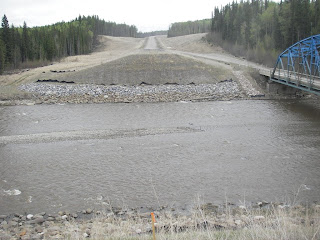Like some many things in life, it's easy to get bored with the familiar. Hence, I don't see the same fascination with my job that others do. But then again, I do enjoy my job and find it interesting.
As I'm stuck out away from Mrs. Spit for a while, I thought that I'd share a little bit of what my working life is like. In the process, I'll show you what goes on to build a new bridge - or two.
First off, here's the site.
 It's an old truss, 68.6 m /225' long, with two 11 m / 36' long concrete spans - one at each end of the truss. This bridge was built in 1945. Sometime in the early 80s it was moved to the present location, crossing the Pembina River approximately 85 km southeast of Edson, Alberta. The bridge used to do its job just fine. And then the industrial (read oilfield) traffic on the road increased. Along with this is the need for larger loads, both in mass and physical size. This bridge is a single lane truss that has a limited vertical clearance of 4.7 m /15'-5" - well below the standard in Alberta of 5.4 m / 17'-8". The design was done years ago, with the bridge being the last part of the puzzle to be built. The road was upgraded and done in 2002, but due to many factors, it had to wait until this year to get started on the replacement.
It's an old truss, 68.6 m /225' long, with two 11 m / 36' long concrete spans - one at each end of the truss. This bridge was built in 1945. Sometime in the early 80s it was moved to the present location, crossing the Pembina River approximately 85 km southeast of Edson, Alberta. The bridge used to do its job just fine. And then the industrial (read oilfield) traffic on the road increased. Along with this is the need for larger loads, both in mass and physical size. This bridge is a single lane truss that has a limited vertical clearance of 4.7 m /15'-5" - well below the standard in Alberta of 5.4 m / 17'-8". The design was done years ago, with the bridge being the last part of the puzzle to be built. The road was upgraded and done in 2002, but due to many factors, it had to wait until this year to get started on the replacement.Here is the crossing for the new bridge.
 The road fill has already been constructed. You can see the heavy rock armour along the base of the bank. We call this riprap. It's an odd word that I had never heard before I started working in engineering. The online etymology dictionary says this for the origin:
The road fill has already been constructed. You can see the heavy rock armour along the base of the bank. We call this riprap. It's an odd word that I had never heard before I started working in engineering. The online etymology dictionary says this for the origin:"loose stone thrown down in water or soft ground as foundation," 1822, Amer.Eng., from earlier nautical meaning "stretch of rippling water" (often caused by underwater elevations), 1669, probably of imitative origin.
It protects the bank from erosion when the water levels rise. The biggest enemy of any bridge is, strangely enough, the water that it crosses. So much of what we do and how we do it has to do with protecting the bridge from the water - and in these enlightened times - protecting the water from the effects of constructing the bridge. As such, we won't be touching the river until the environmental folks tell us that we can - starting in July.
Looking at the crossing, you can see a nice gravel bar conveniently placed at the center of the river. Engineers being clever, they decided that this would be an excellent place to have a bridge pier. Not only does the river already not want to be in that particular stretch, but it left behind gravel for us. Of course, we don't found our bridges on gravel. It turns out that below the riverbed, there is a nice strong layer of clay shale, underlain with bedrock. That's what we will be founding the bridge on. Lots more on this in a future post.
The new bridge going into this site will be a fairly large one - one of the larger bridges that my company has built since they started having a bridge department about 12 years ago. It's what we call a "showcase" project. And for good reason - the bid cost for the new bridge is $6.7 million. You can build a lot of gravel road for that kind of cash. The final structure will have two spans, with each span being 49 m / 160' long. It will be built using steel girders onto which a high strength concrete vehicle deck will be cast-in-place. The pier will be a monolithic concrete pier. All told, it will be a pretty big beast.
Next stop, the foundations.


No comments:
Post a Comment